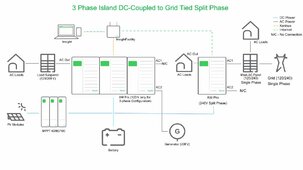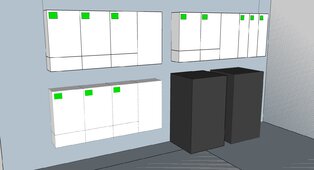I have a small cabinet-making business in MA/NH and am considering a property in NH. However, I will need 3-phase power (10-20kW loads & ~1MWhr/mo). 3-phase is about 1mi away and estimates are $90/ft.
I expect something similar to this: https://solar.se.com/us/wp-content/...ase-DC-Coupling-Triple-Inverter-System@1x.png but I've modified the diagram (see attached). The solution doesn't have to be Schneider, but they have a very good rating for short term peak loads.
The 3 phase XW Pro's would not be grid-tied (but, perhaps generator tied). The MPPT's (10-20kW PV) would charge a common battery (30-60kWhr) between the 3 phase XW's and 1 or 2 split phase XW's (12kVA). The split phase would be grid-tied for charging (winter) or sell-back (spring-fall).
I expect to phase the installation. 1st the grid-tied split phase and ~10kW solar, then 30kWhr battery, then the 3 phase, finally increasing battery / PV depending on my demand.
I would think there's a market of small rural manufacturing businesses that are just a little too far from 3-phase and want predictable OPEX.
How feasible/reasonable/reliable is it to DC-couple a 3-phase island (microgrid) with grid-tied split phase inverters? I don't want to invent or be a beta site but don't mind a new use of proven subsystems. The investment in a rural property and daily operation depends on a solid power system.
I expect something similar to this: https://solar.se.com/us/wp-content/...ase-DC-Coupling-Triple-Inverter-System@1x.png but I've modified the diagram (see attached). The solution doesn't have to be Schneider, but they have a very good rating for short term peak loads.
The 3 phase XW Pro's would not be grid-tied (but, perhaps generator tied). The MPPT's (10-20kW PV) would charge a common battery (30-60kWhr) between the 3 phase XW's and 1 or 2 split phase XW's (12kVA). The split phase would be grid-tied for charging (winter) or sell-back (spring-fall).
I expect to phase the installation. 1st the grid-tied split phase and ~10kW solar, then 30kWhr battery, then the 3 phase, finally increasing battery / PV depending on my demand.
I would think there's a market of small rural manufacturing businesses that are just a little too far from 3-phase and want predictable OPEX.
How feasible/reasonable/reliable is it to DC-couple a 3-phase island (microgrid) with grid-tied split phase inverters? I don't want to invent or be a beta site but don't mind a new use of proven subsystems. The investment in a rural property and daily operation depends on a solid power system.




